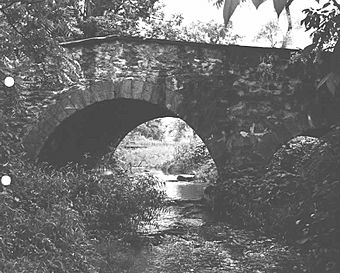Bridge in Williams Township facts for kids
Quick facts for kids |
|
|
Bridge in Williams Township
|
|

Bridge in Williams Township, 1982
|
|
| Location | Legislative Route 48007 over Frey's Run near Stouts, Williams Township, Pennsylvania |
|---|---|
| Area | less than one acre |
| Built | 1857 |
| Architectural style | Multi-span camelback arch |
| MPS | Highway Bridges Owned by the Commonwealth of Pennsylvania, Department of Transportation TR |
| NRHP reference No. | 88000855 |
| Added to NRHP | June 22, 1988 |
The Bridge in Williams Township is a really old and cool stone bridge located in Williams Township, Northampton County, Pennsylvania. It crosses a small stream called Frey's Run. This bridge was built way back in 1857, making it over 160 years old! It's special because it has three arches and a unique "camelback" shape.
In 1988, this historic bridge was added to the National Register of Historic Places. This means it's recognized as an important part of history that should be protected.
Exploring the Williams Township Bridge
This historic bridge is made of strong stone. It has three main sections, or "spans," that create its unique look. The bridge is about 80 feet long and 25 feet wide. Each of its three arches is shaped like a half-circle. These arches are 15 feet wide and 10 feet tall.
What is a Camelback Bridge?
The Williams Township Bridge is known as a "camelback" bridge. This name comes from its shape. Imagine the humps on a camel's back! A camelback bridge has a curved top that rises in the middle, just like a camel's hump. This design helps the bridge be very strong and stable. It also allows water to flow easily underneath.
Why is This Bridge Important?
The Bridge in Williams Township is important for a few reasons. First, it's a great example of how bridges were built in the mid-1800s. It shows the skill of the builders who used stone to create lasting structures. Second, it has served the community for over a century, helping people travel across Frey's Run. Being on the National Register of Historic Places means it's a valuable piece of history. It reminds us of the past and how things were built long ago.



